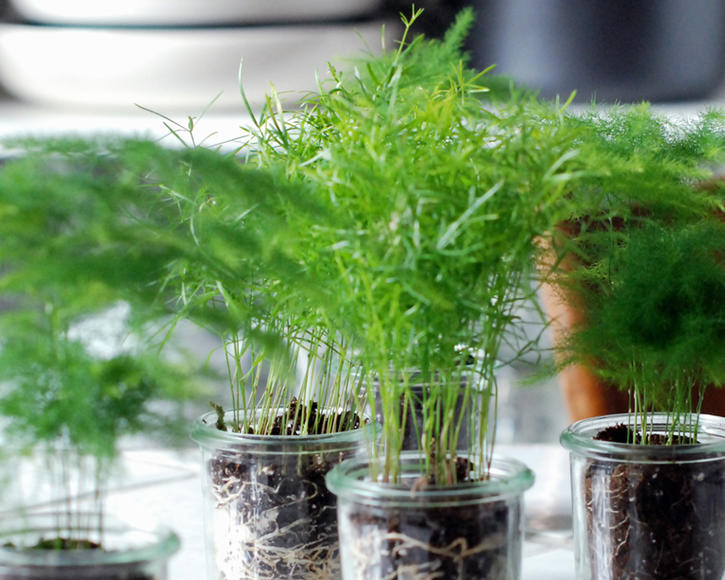Asparagus Fern
Asparagus fern is an uncomplicated houseplant for bright and warm rooms. We take a closer look at the evergreen ornamental foliage plant and provide you with some planting and care tips.
Factsheet
- Growth type
-
- half shrub
- Tuber
- Growth height (from)
- from 30 cm to 100 cm
- Growth characteristics
-
- sweeping
- upright
- overhanging
- Flower color
-
- white
- Flowering time (month)
-
- June to August
- Flower shape
-
- Uniflorous
- Flower characteristics
-
- unimpressive
- Leaf color
-
- green
- Sheet properties
-
- evergreen
- Fruit color
-
- red
- Fruit shape
-
- Berry
- Fruit characteristics
-
- toxic
- Light
-
- sunny to semi-shade
- Soil type
-
- loamy
- Soil Moisture
-
- fresh to humid
- Lime compatibility
-
- lime-tolerant
- Nutrient requirements
-
- nutrient-rich
- Humus
-
- rich in humus
- Decorative or utility value
-
- Leaf ornaments
- Use
-
- Interior greening
- Planters
- Winter garden
- Warm House
- Garden style
-
- Pot garden
In botanical terms, Asparagus fern (Asparagus densiflorus) belongs to the family Asparagaceae. The similarity between this pretty houseplant and Classic Asparagus (Asparagus offincinalis) is especially clear to kitchen gardeners. Although there are several Asparagus ferns in the genus Asparagus, Asparagus densiflorus is the species most commonly found in stores. Asparagus fern used to be known as Asparagus sprengeri after the botanist Karl Sprenger (1846–1917). It’s thanks to him that the Asparagus fern made it to Europe. The undemanding and very low-maintenance ornamental foliage plant is native to Asia and Southeast Africa. Asparagus fern is often used by florists as cut greenery or foliage for bouquets.
Asparagus fern reaches heights of between 12 and 40 inches. Depending on the variety, growth is more or less upright, and depending on the length of the shoots, it is expansive and arches downwards. The roots are thick and bulbous.
Strictly speaking, the Asparagus fern does not have leaves, but modified side shoots (phylloclades). The "true" leaves of the Asparagus fern have developed into thorns.
With optimal conditions and good care, Asparagus densiflorus forms tiny white flowers in summer. However, it is not a reliable bloomer.
After flowering, small red berries appear on the plant in late summer. Note: Regardless of the species or variety, all Asparagus fern berries are highly poisonous and unfit for human consumption!

Asparagus fern prefers a bright to partially shaded spot indoors at temperatures around 68 degrees Fahrenheit. The plants should be kept slightly cooler in winter, but not below 50 degrees Fahrenheit. However, cooler winter quarters are not essential for the undemanding houseplant. A lack of light can easily cause it to lose its leaves. Asparagus densiflorus can be put outside in a sheltered spot in summer and also thrives on its own in direct sunlight.
If you’re growing the plant indoors, you can use conventional, humus-rich, slightly loamy potting soil which is available from specialist stores. Asparagus fern does not have any specific substrate requirements. It is also suitable for hydroponics.
Asparagus fern cannot tolerate dry conditions. You should keep the houseplant evenly moist all year round, but water it slightly less in winter than in the summer months. If the air indoors is dry, we recommend spraying the plant with water now and again. It is best to avoid using hard water.
Asparagus fern should be fed nutrients on a weekly basis. You only need to use fertilizer once a month in winter.
Asparagus fern likes to be in a relatively large pot, where it can grow for around two to three years. The roots have usually fully penetrated the substrate by then and the plant will need to be repotted.
The low-maintenance houseplant does not actually need pruning. But you can removed withered fronds. As already mentioned, asparagus fern reacts very sensitively to dry conditions. If you forget to water your Asparagus fern, don’t abandon it right away. It’s best to cut it back drastically to just above the soil, put it in a warm spot indoors with a slightly higher humidity and with a little luck, the plant will produce new growth.

Asparagus densiflorus ‘Spengeri’ is particularly good for beginners who don’t have the greenest fingers. It is extremely hard to go wrong when caring for this exceptionally robust variety. Asparagus densiflorus ‘Meyeri’ is very popular due to its bizarre growth. The side shoots and leaf-like side branches of this variety are so dense that it forms foxtail-like fronds, which can grow relatively upright up to a length of 3.5 foot.
Asparagus fern is propagated by dividing the rootstock in spring. Asparagus densiflorus in particular forms very strong tuber-like thickened roots – so use a clean and sharp knife to divide it. Asparagus fern can also be propagated from seed. At normal room temperature, the seeds soon start to germinate. Bear in mind that the seeds germinate in the dark and therefore need to be covered with soil.
In winter in particular, you should regularly check your asparagus fern for infestations of spider mites or aphids. The higher the temperature in its winter quarters, the more susceptible the plant is to pests. Important: Asparagus fern does not tend to like pesticides. You should therefore avoid using them at all costs. Waterlogging can quickly lead to root rot. The plant sometimes reacts to irregular watering, sudden and frequent location changes, temperature fluctuations, and too little light by losing its leaves.

